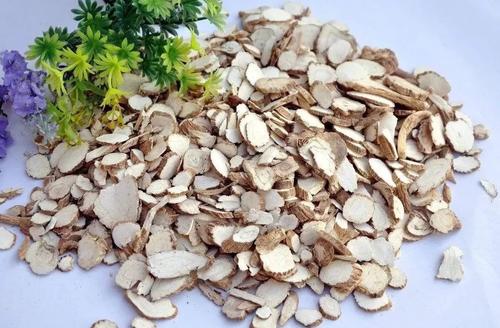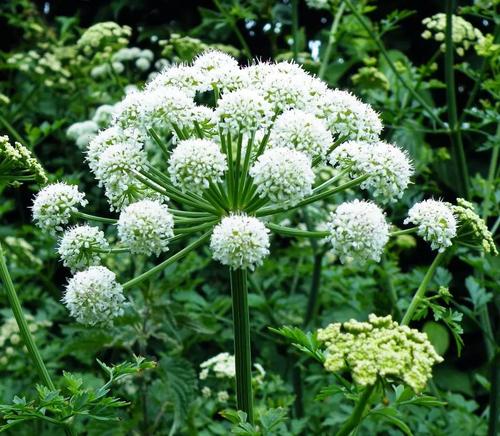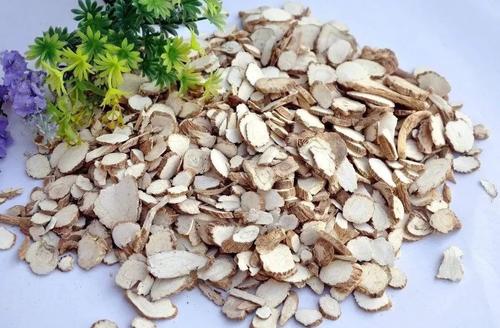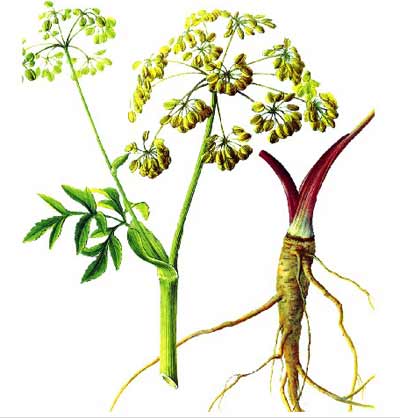Angelica dahurica Profile
Written by Lisa
Nov 09 2020

Angelica dahurica Picture


Angelica dahurica Morphological characteristics
Angelica dahurica is a perennial tall herb, 1-2.5 meters high. The root is cylindrical, branched, 3-5 cm in diameter, and the outer skin is yellowish brown to brown with a strong smell. The base of the stem is 2-5 cm in diameter, sometimes up to 7-8 cm, usually purple, hollow, with longitudinal grooves.
The basal leaves are once pinnately divided, with long stalks, and the lower part of the petiole has a tubular stalk-margin membranous sheath; the upper part of the stem leaves two to three pinnately divided, the outline of the leaf is ovate to triangle, 15-30 cm long, 10-25 cm wide, petiole up to 15 cm long, the lower part is a sac-like enlarged membranous leaf sheath, glabrous or rare hairy, often purple; terminal lobes are oblong, ovoid or linear-lanceolate, mostly absent The stalk, 2.5-7 cm long, 1-2.5 cm wide, sharply pointed, with irregular white cartilaginous coarse serrations on the edge, with short pointed head, often unequal in size on both sides of the base, extending downward along the leaf axis into a wing shape ; The leaves of angelica dahurica below the inflorescence are simplified into leafless, significantly enlarged cyst-like leaf sheaths, with glabrous outside.

Compound umbels are terminal or lateral, diameter 10-30 cm, peduncle 5-20 cm long, peduncle, peduncle and pedicel all have short rough hairs; spoke 18-40, central main umbrella sometimes Up to 70; involucres are usually missing or have 1-2, and grow ovate enlarged sheaths; small involucres more than 5-10, linear-lanceolate, membranous, white flowers; no calyx teeth; petals obovate, The apex is curved into a concave head; the ovary is glabrous or short-haired; the style is twice as long as the base of the short conical style.
The fruit OF Angelica dahurica is oblong to ovoid, yellowish brown, sometimes purple, 4-7 mm long, 4-6 mm wide, glabrous, flat dorsal, thick and blunt round, nearly spongy, much wider than furrows , Side ribs wing-shaped, narrower than the fruit body; there are tubing 1 in the ribs and tubing 2 on the confluent surface. Flowering period from July to August, fruiting period from August to September.
Angelica dahurica Growth Environment
Angelica dahurica often grows under forests, forest edges, streams, shrubs and valleys. It is cultivated for medicinal purposes in northern provinces in China. [1] Angelica dahurica likes a mild and humid climate and a sunny environment, and is resistant to cold.
Angelica dahurica Geographical Distribution
Angelica dahurica is distributed in Northeast and North China and other places in mainland China. Angelica dahurica grows in areas 200 to 1,500 meters above sea level. It is generally born under forests, forest edges, streams, shrubs and valley grasslands.
Latest Updated
- Benefits of Bugleweed - 7 Science-backed Health Benefits
- Bugleweed Dangers & Side Effects - Is It Poisonous?
- How to Plant Evergreen Trees - What You Should Know
- When to Plant Evergreens - Grow Guide for Evergreen Trees
- 12 Wonderful Evergreen Shrubs for Your Garden
- 12 Popular Evergreen Plants with Pictures for Beginners
- When And How To Prune A Lilac Bush Like a Pro
- How to Grow & Care for Lilac Vine (Hardenbergia Violacea)
- Japanese Lilac Tree (Syringa Reticulata) Care & Propagation Guide
- Shumard Oak Pros and Cons - What to Know
Popular Articles
- Winter maintenance of Antirrhinum Majus
- How to Grow Terminalia Mantaly Tree
- How to Grow and Care for Crossostephium Chinense
- How to grow Antirrhinum Majus in spring
- Peristeria Elata (Dove Orchid) Profile: Info & Care Guide
- Underwatered Snake Plant (Sansevieria Trifasciata) - Signs And How To Fix
- How to Care for Brazilian Jasmine Plant (Mandevilla Sanderi)
- How to Grow & Care for Graptopetalum Purple Delight in Summer
- Rosa Chinensis (China Rose): Plant Growing & Care Tips
- How to Care for Baby Sun Rose (Aptenia Cordifolia)